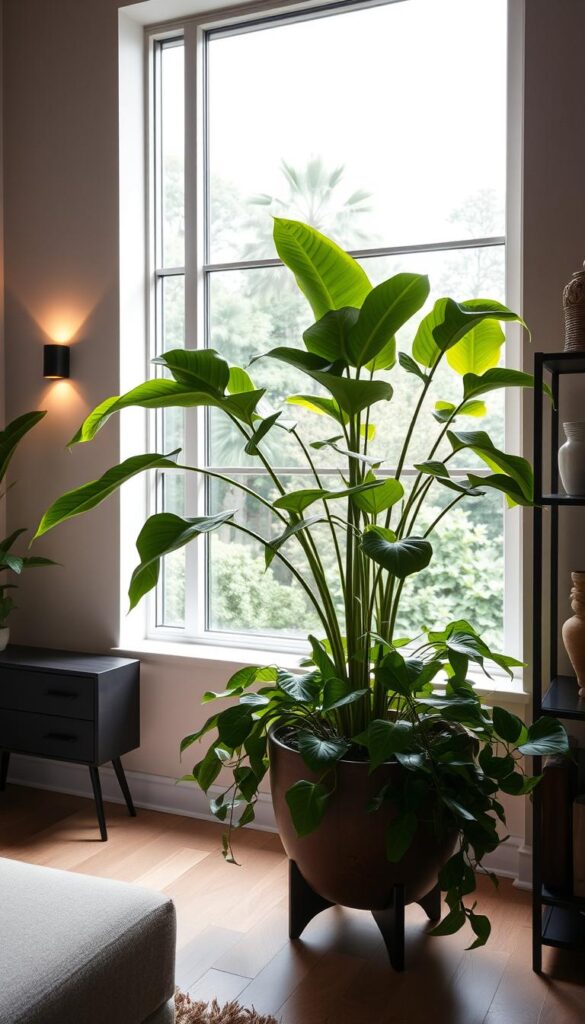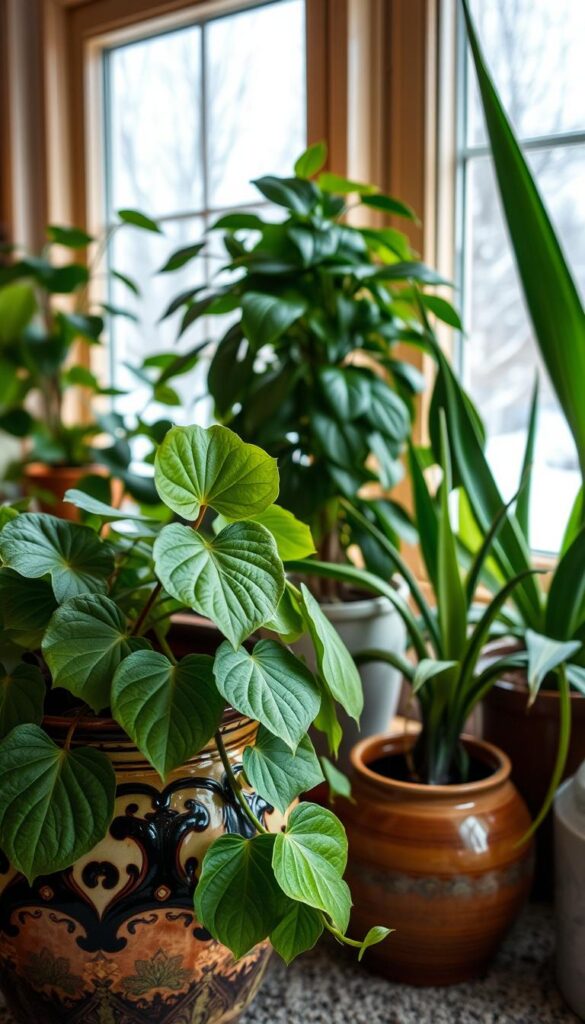Meet the Philodendron Pedatum, a stunning houseplant that has captured my heart with its unique, lobed leaves and graceful growth. My journey with this plant began when I first brought it home, drawn by its striking appearance. Over time, I’ve learned the ins and outs of keeping it happy and thriving.
Watering is one of the first lessons I learned. I discovered that this plant prefers consistent moisture but hates sitting in water. In fact, during the spring and summer months, I water it with about 0.5 cups of water every 9 days when it’s in indirect sunlight. This balance keeps the soil just right—not too dry, not too soggy.
Lighting is another crucial factor. While it can tolerate low light, it really shines in bright, indirect sunlight. I’ve found the perfect spot for mine near an east-facing window, where it gets plenty of light without being scorched by direct rays.
Repotting is something I look forward to every spring. It’s a great opportunity to give my plant a fresh start with new soil and a slightly larger pot. This not only gives the roots room to grow but also refreshes the soil’s nutrients.
Understanding these care routines is essential for keeping your Philodendron Pedatum healthy and vibrant. In this guide, I’ll share everything I’ve learned, from the basics to more advanced techniques, to help you enjoy the beauty of this incredible plant as much as I do.
Understanding My Philodendron Pedatum
Discovering the unique charm of my Philodendron Pedatum has been a delightful journey. This plant captivates with its distinctive lobed leaves and slender stems, making it a standout in any room.
Key Characteristics and Unique Traits
The Philodendron Pedatum boasts striking, hand-like lobed leaves that give it a unique appearance. Its stems, tinted with reddish-brown hues, add a touch of elegance. The glossy texture of the leaves enhances its visual appeal, making it a favorite for indoor spaces.
Native Region and Growth Habit
Originating from Central and South America, this plant naturally grows with a climbing habit. I enjoy training its stems to climb up support structures, which not only enhances its beauty but also promotes healthy growth. Understanding these traits helps in replicating its native environment indoors, ensuring it thrives.
Creating the Ideal Environment for My Plant
Setting up the perfect environment for my plant involves balancing several key factors. Water, soil, drainage, light, temperature, and humidity all play crucial roles in its health and growth. By carefully managing these elements, I can ensure my plant thrives indoors.
Watering, Drainage, and Soil Mixtures
To create an ideal environment, I start with the soil. I use a well-draining mix enhanced with perlite or coco coir to prevent waterlogged soil. This helps maintain the right moisture levels without risking root rot. My watering routine involves checking the soil dryness and using a water calculator for precise recommendations. This approach ensures the soil is consistently moist but never soggy.
| Factor | Ideal Setup | Benefits |
|---|---|---|
| Soil Mix | Well-draining mix with perlite or coco coir | Prevents waterlogging, promotes healthy roots |
| Watering Routine | Check soil dryness; water when top 1-2 inches are dry | Maintains optimal moisture, prevents root rot |
| Light Placement | Near a south-facing window, indirect sunlight | Provides bright light without direct sun exposure |
| Temperature | 65-75°F (18-24°C) | Mimics natural tropical conditions |
| Humidity | 50-60% | Supports leaf health and growth |
Light, Temperature, and Humidity Needs
Light is another critical factor. I place my plant near a south-facing window, ensuring it gets bright, indirect light. Direct sunlight can scorch the leaves, so balance is key. Temperature-wise, I keep it between 65-75°F, mirroring its tropical origins. Humidity is maintained around 50-60% to support healthy growth and prevent leaf issues. By controlling these factors, I create a nurturing environment that promotes robust plant health and vitality.

philodendron pedatum care guide for Optimal Growth
Keeping my Philodendron Pedatum thriving involves a mix of attention to detail and understanding its unique needs. By tailoring my care routine, I ensure it stays healthy and vibrant.
Personalizing My Watering Schedule
Watering is where I start. I check the soil moisture by sticking my finger into the soil up to the first knuckle. If it feels dry, it’s time to water. I use a watering can with small holes to control the flow and prevent overwatering. During spring and summer, I water every 7-10 days, while in fall and winter, I extend it to 4-6 weeks. This adjustment helps me match the plant’s growth cycle.
- I use a water calculator to measure the right amount based on pot size and soil type.
- I avoid getting water on the leaves to prevent fungal diseases.
- I let the pot drain fully to ensure no water pools at the bottom.
Balancing Nutrients for Lush Foliage
Nutrient balance is crucial. I repot my plant every spring with fresh, well-draining soil. This gives the roots room to grow and replenishes the soil’s nutrients naturally. I don’t use extra fertilizer, as the new soil provides enough nutrients for healthy growth. This approach keeps the leaves lush and vibrant without overloading the plant with chemicals.
Propagation and Troubleshooting Tips for My Pedatum
Sharing my journey with Philodendron Pedatum, I’ve learned effective ways to propagate and troubleshoot common issues. This section covers practical methods and solutions to keep your plant thriving.
Stem Cuttings, Air Layering, and Other Methods
Propagating Philodendron Pedatum can be done through stem cuttings or air layering. For stem cuttings, I select healthy stems with nodes, cut them just below a node, and plant them in moist potting soil. Air layering involves wrapping a moist medium around a stem section on the plant, which develops roots before cutting. Both methods require patience but yield great results.
Identifying and Fixing Common Care Issues
Common issues include yellow or brown leaves, often due to overwatering. I check the soil moisture and adjust my watering schedule. Root rot is a risk, so well-draining soil is essential. Pests like spider mites can appear, treated by isolating the plant and using insecticidal soap. Each challenge is an opportunity to refine my care routine.
- Check soil moisture regularly to prevent root rot.
- Isolate plants when pests are detected to avoid spread.
- Adjust watering based on seasonal growth patterns.
By addressing these issues thoughtfully, I ensure my Philodendron Pedatum remains healthy and vibrant.
Seasonal Adjustments and Advanced Care Techniques
As the seasons change, so does my approach to nurturing my plant. Understanding how to adapt care routines to different times of the year is crucial for maintaining health and vitality.
Managing Winter and Dormancy Phases
During the winter months, my plant enters a dormant phase, growing much slower. I reduce watering to about 0.25 cups every 12 days, ensuring the soil dries out more between waterings. This prevents root rot and matches the plant’s reduced water needs.
| Season | Watering Adjustment | Benefits |
|---|---|---|
| Winter | Water every 12 days with 0.25 cups | Prevents root rot, matches slower growth |
| Summer | Water every 9 days with 0.5 cups | Supports active growth, maintains moisture |
Preventing Root Rot and Dealing with Pests
Root rot is a common issue, especially in winter. I ensure proper drainage by using a well-draining soil mix. If I notice yellowing leaves or soft stems, I inspect the roots and trim any affected areas.
- Monitor for pests like spider mites and mealybugs regularly.
- Isolate infected plants to prevent spread.
- Use insecticidal soap to treat infestations.

Final Reflections on Nurturing My Philodendron Pedatum
Reflecting on my journey with the Philodendron Pedatum, I am reminded of the joy it brings to my home every day. This plant has taught me the importance of balance—whether it’s the right amount of sunlight or the perfect level of moisture. Over time, I’ve learned to recognize the subtle signs of its needs, like droopy leaves or a change in color, which guide my care routine.
Creating the ideal spot for my Philodendron Pedatum has been a process of trial and error. I’ve experimented with different pot sizes, hanging setups, and even various soil mixes to find what works best. Each day, whether in low light or bright conditions, I’ve seen how consistent attention contributes to its health and vitality.
One of the most valuable lessons I’ve learned is the importance of patience. From dealing with root rot to managing pests, every challenge has been an opportunity to refine my skills. These experiences have not only helped my plant thrive but also deepened my appreciation for the natural world.
As I look back, I am grateful for the ways this journey has enriched my home. It’s more than just a plant—it’s a reminder of the beauty and resilience of nature. To fellow plant enthusiasts, I encourage you to embrace the journey of nurturing your own Philodendron Pedatum. With time and attention, you’ll find it to be a truly rewarding experience.
